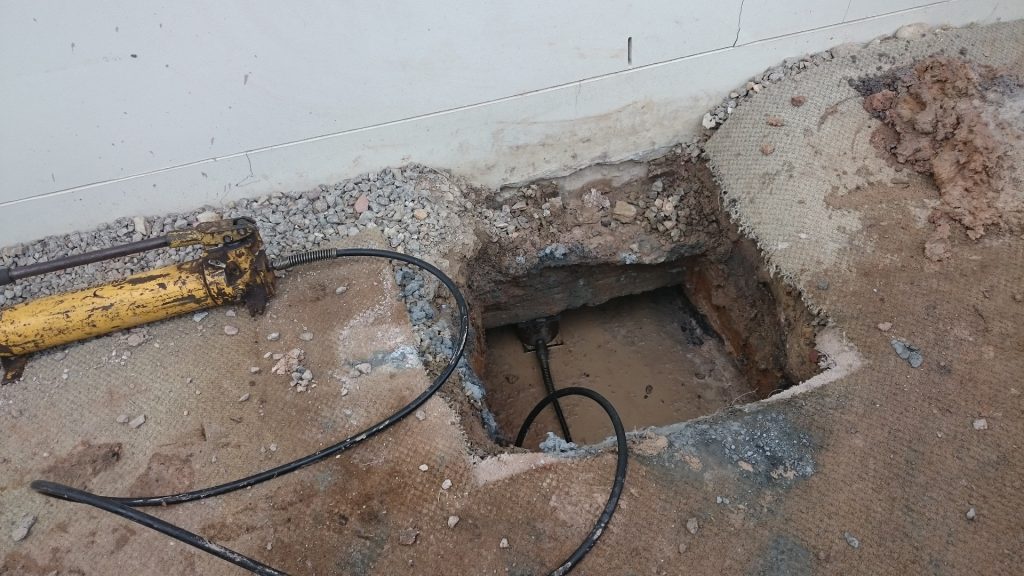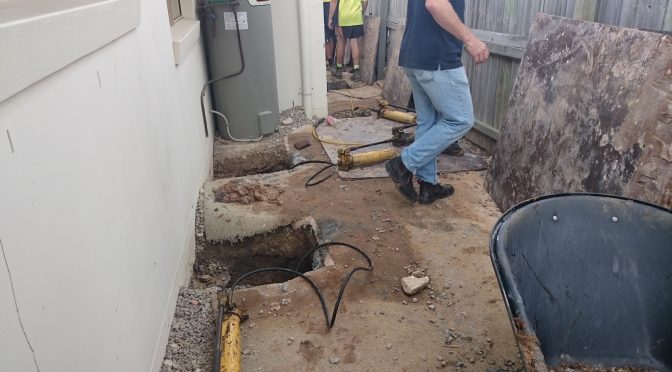Do you think your house needs underpinning?
Is it because your house has cracks in it? Is it because your neighbour had their house underpinned? Is it because you don’t have time and you need your house fixed NOW? Is it because some random salesperson said you do?
It’s time to have your house assessed properly before you weigh up the options for underpinnings and house repairs.
OK. Underpinning is awesome. It can be used to help stabilise (and even reverse) downward movement of a building. The building might have cracks in it or the floor might be uneven.
However, underpinning isn’t the answer to every “my house is dropping” problem we encounter.

At Cornell Engineers, we use underpinning for a specific issue – one way foundation settlement that is unlikely to reverse in time.
So how do you know if your house needs underpinning and not some other type of crack repair method? Let’s find out.
What is Underpinning Of a House?
Before we get into whether you need underpinning, let’s quickly check out what underpinning of a house is.
Underpinning is a construction process that adds extra footings beside and under your house so that your house is supported on soil that is more stable than the soils your home currently sits on.
The purpose of underpinning is to make your footings more stable, stronger and less likely to be move in the future.

Underpinning work is normally done by a professional building company that specialises in underpinning – but underpins can be installed by a competent home builder almost as easily.
Does my home need underpinning?
The appearance of cracks in the walls, ceiling and floors sometimes does mean your house is moving.
Does your home need underpinning? Not necessarily.
Underpinning is most beneficial when a house has been built on soft or loose soil (such as uncontrolled fill). If your house footings weren’t originally installed deep enough then underpin footings are used to improve the stability of your house. They can even be used to jack your house back up to almost level.
However sometimes, and more likely, damage in a house is caused by uneven soil moisture conditions causing uneven swelling and shrinking of reactive clay soils. See our articles on Slab Heave.
This movement is seasonal and/or can be reversed. In our opinion, underpinning IS NOT the best way to solve issues with reactive clay movement.
How do I know if I need Underpinning?
An underpinning contractor IS NOT the best person to ask to see if you need underpinning. What answer do you expect? “Of course you do!”, is what I would expect to hear.
But is it correct?
The best underpinning contractors recommend you get advice from a qualified structural engineer before you embark on the expensive, messy work involved in underpinning a house.
Even an experienced structural engineer doesn’t know if you need to underpin your house until:
- They have inspected your house in person.
- They have assessed the movement in your house and found it to be caused by the consolidation of soft soil.
- They have read your soil test and/or arranged for an independent soil test.
- They have recorded floor levels through your house to diagnose the cause of the damage in your house.
- They have eliminated the other causes of uneven movement in houses and determined that underpinning is the best remaining alternative for permanently stabilising your home.
Do You need to Underpin?
Start with an assessment of the damage in your home by a qualified, independent structural engineer.
(Unless you have too much money – in which case the donation account for St Vincent de Paul is BSB: 062000 Account number:1055 0483 – PS love your work St Vinnines!!)
Some engineers aren’t qualified. Some engineers aren’t independent. It’s a little more work for you but it reduces the risk of getting work done that you don’t really need. So do your research and make sure you can trust the engineer you engage to give you advice.
Then, armed with a set of engineer’s plans and a soil test, you can get prices from underpinning contractors. You’ll be getting more competitive prices for your underpinning and have the comfort of having engaged a qualified engineer.
Resin Injection vs Concrete Underpinning
We’re back to having too much money. If you consider resin injection technology used for re-levelling buildings and other on-ground structures before you have an assessment by a qualified structural engineer, then yes, you have too much money.
Resin injection is botox for homes and it’s just as short-term, expensive and prone to mistakes.

Again. Why would you ask a contractor that specialises in resin injection technology whether you need their product to rectify your slab and close up the cracks in your home?
What answer do you really expect?? They will say “Yes, you do” and take your money every time.
So here’s the warning:
If you use resin injection technology to raise your sunken slab or footings in any part of your house, you are on your own!
Our preferred method of stabilising and fixing a home is to undo the changes in the ground conditions that are causing your house to move and crack. Once you inject that gunk into the ground under your house, we can’t fix your home.
This is because the ground conditions under your home are now substantially and irrevocably changed.
We can’t undo that stuff.
Either call the ground injection company back and try and get your house fixed under their warranty scheme or learn to live with the movement and damage. It really is that futile.
A Three-Point Action Plan
If your house is moving and/or cracking, these are my recommendations:
- Contact a local, qualified structural engineer to inspect and assess the damage in your home. Do a quick Google like this one:
https://www.google.com/search?q=house+cracking+structural+engineer - Speak to a couple of engineers. Get a feel for how responsive they are and how knowledgeable they are. Do they sound like salespeople or do they actually want to help?
- With an engineer’s report in hand, start the rectification process. it’s not always quick and simple – but it really depends on your circumstances, your budget and what is causing the damage.
OK. best of luck resolving the issues with your home.
If your home needs underpinning (or not) let us know. Comment below or post a comment on our Facebook page.

